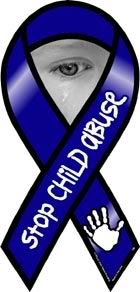- Maltreatment of Children with Disabilities Greater
-
"Maltreatment of individuals with disabilities may be committed by only a few, but the responsibility to protect them belongs to us all."
-Mitchell & Buchele-Ash, 2000, p. 239
DON'T FORGETSTOP CHILD ABUSE NATIONAL DAY OF HOPE.
Children with disabilities are more at risk of abuse and neglect than children without disabilities. Child maltreatment, also known as abuse and neglect, affects all types of children, but children with disabilities may be at even greater risk of being maltreated than children without disabilities (Crosse, Kaye & Ratnofsky)- 21.3 per 1,000 children without disabilities are maltreated each year in the USA ,
- 35.5 per 1,000 children with disabilities are maltreated each year in the USA.
Put another way, approximately 175,000 to 300,000 U.S. children with disabilities are maltreated each year, if it is estimated that between 9 percent and 15 percent of all children in the United States have a disability of some kind.
The factors that place these children at higher risk include factors that place all children at risk of maltreatment in addition to other risk factors that are more directly related to disabilities. These include:
- Societal attitudes about disabilities
- Peoples' reactions to, and interactions with, children with disabilities (including family members and non-family caregivers)
- Factors that relate to the disability itself
- Program policies and procedures governing the care of children by others.
Maltreated children with disabilities were disproportionately white as compared to maltreated children without disabilities
Maltreated children with disabilities were more likely to be male than maltreated children without disabilities, although it should be noted that more males are diagnosed with disabilities.
Children with disabilities tended to be maltreated multiple times and in multiple ways. (Sullivan and Knutson)
Perpetrators:
Most studies of adult perpetrators indicate that the majority of perpetrators are family members; this is true for maltreated children with and without disabilities.Among all family members, mothers are most frequently the perpetrators of maltreatment , although it should be noted that mothers are most often the primary caretakers of children (Sobsey, 1994).
Sexual abuse of children with disabilities is more often committed by males who are not relatives of the victims; this is also true for children without disabilities who are sexually abused (Sobsey, 1994; S).
Non-family members who maltreat children with disabilities come in contact with their victims in many different ways. Perpetrators can include teachers, health care providers, residential care providers, transportation staff, volunteers, babysitters, and peers (Ammerman & Baladerian, 1993; Sobsey, 1994)
Is There a Relationship Between the Type of Maltreatment
and Type of Disability?
Some studies have explored the relationship between the type of maltreatment and type of disability. Child welfare agencies generally group maltreatment into four categories:physical abuse, sexual abuse, neglect, and emotional maltreatment.
Likelihood of Maltreatment of Children with Disabilities Compared to Children without Disabilities, by Type of Maltreatment Type of Maltreatment Crosse et al., not dated Sullivan & Knutson, in pressNeglect 1.6 times as likely 3.8 times as likely Sexual Abuse 1.8 times as likely 3.1 times as likely Physical Abuse 2.1 times as likely 3.8 times as likely Emotional Maltreatment 2.8 times as likely 3.9 times as likely - These studies both found that neglect was the most common form of maltreatment for children with disabilities
- Both of these studies also explored which types of disabilities place children at greatest risk of maltreatment: mental disability, speech/language impairments, emotional disabilities, learning disabilities, and physical health impairments. Sullivan and Knutson also included hearing and visual impairments.
- Both studies found that of all types of disabilities, emotional and behavioral disorders showed the highest prevalence rate of abuse and neglect.
- Sullivan and Knutson ( found that children with behavioral disorders were at highest risk, followed by children with speech/language disorders, mental retardation, and health impairments.
- Crosse et al. (n.d.) found that serious emotional disturbance puts children at the highest risk, followed by learning disabilities, speech/language impairments, and physical health problems.
Primary prevention efforts can improve conditions for all families that have children with disabilities and secondary prevention programs can target children and families who are at high risk of maltreatment.
References:Ammerman, R.T. & Patz, R. J. (1996). Determinants of child abuse potential: Contribution of parent and child factors. Journal of Clinical Child Psychology, 25(3), 300-307.Baladerian, N.J. (1994). Abuse and neglect of children with disabilities. ARCH National Resource Center for Respite and Crisis Care Services.
Crosse, S.B., Kaye, E. & Ratnofsky, A.C. (n.d.). A report on the maltreatment of children with disabilities. Washington, D.C.: National Center on Child Abuse and Neglect, DHHS.
Sobsey, D. (1994). Violence and abuse in the lives of people with disabilities: The end of silent acceptance? Baltimore, MD: Paul H. Brookes Publishing Co.
Sullivan, P.M. & Knutson, J.F. (in press). Maltreatment and disabilities: A population-based epidemiological study. Child Abuse and Neglect.
DON'T FORGET WEDNESDAY IS
STOP CHILD ABUSE NATIONAL DAY OF HOPE.Tags: childabuse:childrenwithdisabilities | Edit Tags Wednesday April 4, 2007 - 02:10am (EST)
Sunday, June 21, 2009
Maltreatment of Children with Disabilities Greater
Subscribe to:
Post Comments (Atom)






No comments:
Post a Comment
Comments